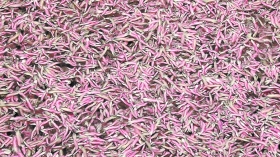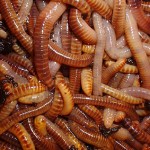Millions of bristle warms swarmed Californian Vilano Beach

Vilano Beach waters swarmed with worms early Monday morning for a ritual nature event that only happens once a year.
Millions upon millions of red marine worms could be seen from the surface as they zipped around shallow Vilano Beach waters around 3 a.m. Monday. According to Florida Fish and Wildlife Conservation Commission Public Information Coordinator Karen Parker, these “many-haired-segment worms” come to the surface at night once a year to reproduce.
“This is a common occurrence during their particular spawning time,” Parker said. “Most of the time this mass spawning occurs at night during a particular moon phase or when the water reaches a certain temperature.”
 Millions of worms covered the surface of the water, making it impossible to see through all of the fast-moving bodies to the deeper water underneath. FWC biologists believe the worms are of the polychaete species, which are red in color and commonly called bristle worms because of their many leg-like feelers. It’s not unsual that they reproduce in the spring.
Millions of worms covered the surface of the water, making it impossible to see through all of the fast-moving bodies to the deeper water underneath. FWC biologists believe the worms are of the polychaete species, which are red in color and commonly called bristle worms because of their many leg-like feelers. It’s not unsual that they reproduce in the spring.
“Several species of segmented marine worms reproduce by developing a reproductive portion of their body which then breaks off from the main body and rises into the water column in mass spawning aggregations, or the entire animal rises into the water column for this mass spawning.“
Some of the marine worms that perform this sort of mass spawning ritual are the luminescent threadworms, the Atlantic palolo and clamworms. Although it is “truly amazing” for some to witness this event, local fishermen think otherwise. Many fish gorge themselves on the worms and (may) not bite for some time. (St.AugustineRecord)
Bristleworms range in size from about 1-inch long up to about 20 inches in length. Most small ones are an orange color, but occasionally appear two-tone in color. Larger bristleworms are frequently gray or brownish in color. Bristle worms are composed of many segments and have bristles (setae) which extend from both sides of its body along its entire length, hence their common name.
Bristleworms live in the sand or within the live rock. They are nocturnal and not usually seen during the day.
Historically, bristle worms were all considered to be bad. Most literature warns that they can attack and eat clams, anemones, corals and even fish. (News4Jax)

Commenting rules and guidelines
We value the thoughts and opinions of our readers and welcome healthy discussions on our website. In order to maintain a respectful and positive community, we ask that all commenters follow these rules.